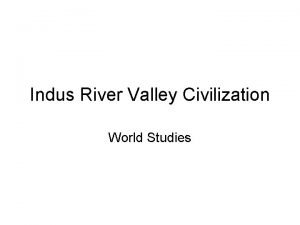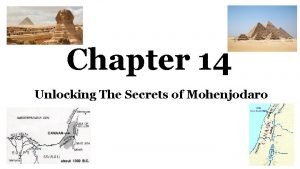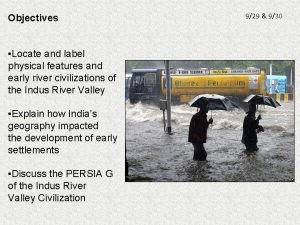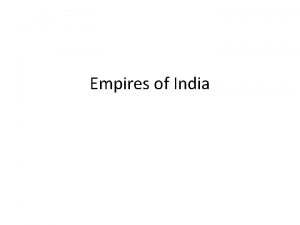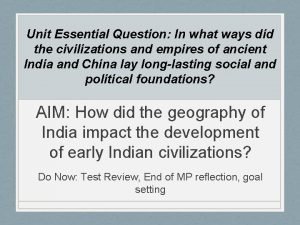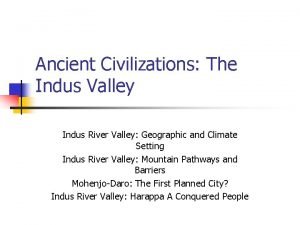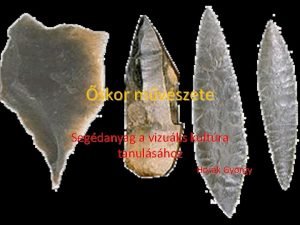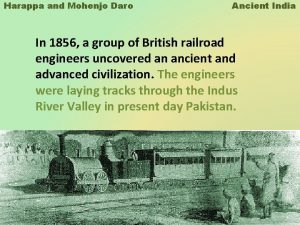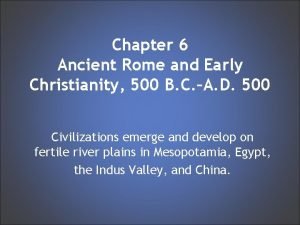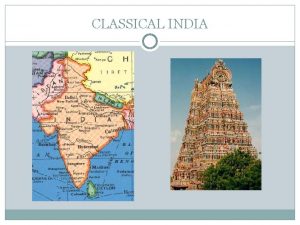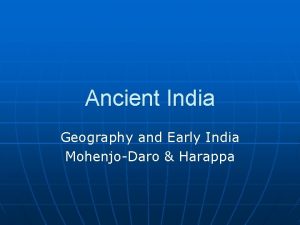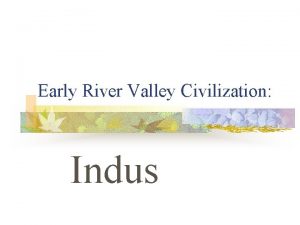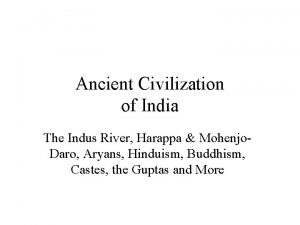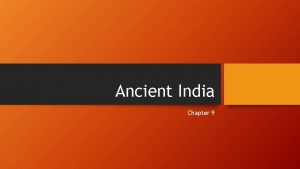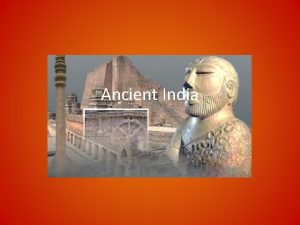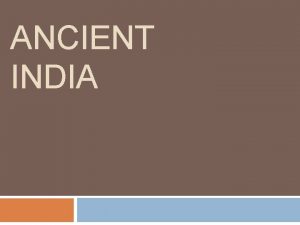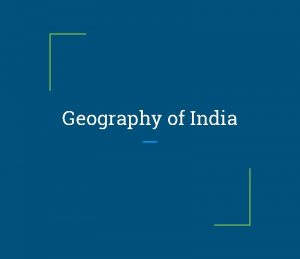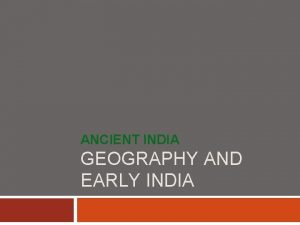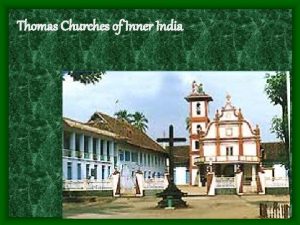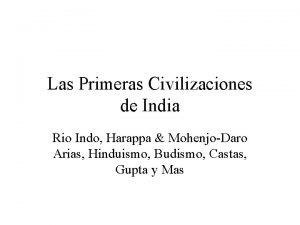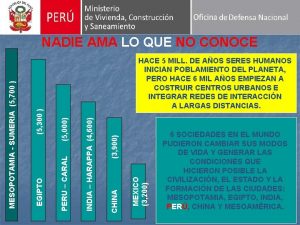Ancient India Geography Early India Mohenjo Daro Harappa




















- Slides: 20

Ancient India Geography & Early India Mohenjo- Daro & Harappa

The Indus Valley Civilizations thrived between 2300 -1700 B. C.

Geography of India • The geography of India includes high mountains, rivers, and heavy seasonal rain. • India is so large that it is referred to as a subcontinent. (A large landmass that is smaller than a continent. They are usually separated from the rest of their continent by physical features. ) India is separated from Asia by the Himalayan Mountains in the north and the Hindu Kush Mountains in the west. • West of the Himalayas is a vast desert. • The rest of India is covered by fertile plains and rugged plateaus.

Indus River Valley Today • https: //www. youtube. com/watch? v=x. Q_po. CVDBn. Q

https: //www. youtube. com/watch? v=j 7 YXme 9 ml 2 c OVERVIEW from GEOgraphy – Aryan Invasion – Caste – Hinduism – Reincarnation-Karma n he o M aro D jo ppa a r Ha d Ve a S s– ers t cri s an - t a m a rd e H a Sid h th r a u a G

Geography of India- Cont. • The Indus Valley was the location of India’s first civilization. • The Indus Valley is located west of India in present-day Pakistan. • When heavy snows in the Himalayas melted, the Indus River flooded. Like Mesopotamia and Egypt, the flooding left a layer of fertile silt. The silt created ideal farmland for early settlers.

Climate • In summer some parts of India receive as much as 100 -200 inches of rain. • The climate of India is mostly hot and humid. India’s monsoons (seasonal wind patterns that cause wet and dry seasons) influence the climate in India. • In winter, the winds that blow down the mountains force moisture out of India to create warm, dry winters.

India – Physical Map • Monsoo n June 2016: http: //edition. cnn. com/vide os/weather/2 016/06/09/in dia-monsoonseasonjavaheri-cnninr-lklv. cnn

Harappan Civilization • Historians called the civilization that grew up in the Indus Valley the Harappa Civilization. • Like other civilizations, towns and cities grew once food surpluses resulted from progress in irrigation and agriculture.

India’s First Cities • The Harappan civilization is believed to have thrived between 2300 -1700 B. C. • The Harappan civilization consists of two large and several other smaller cities. Harappa and Mohenjo Daro both lay on the Indus River about 300 miles apart. • Characteristics of Harappa & Mohenjo Daro : 1. Well planned 2. protected by fortresses 3. brick streets that crossed at right angles 4. storehouses 5. workshops, market stalls, and houses 6. public wells.


Ancient Indian Bath

Harappa Latrine https: //www. harappa. com/search/site/latrine Many houses had latrines that were distinct from the bathing areas. The early excavators at Harappa and Mohenjo-daro did not pay much attention to this feature of the Indus cities, but current excavations at Harappa are finding what appear to be latrines in almost every house. The commodes were made of large jars or pot sunk into the floor, and many of them contained a small jar similar to the modern jar used throughout Pakistan and India for washing after using the toilet. Sometimes these pots were connected to a drain to let sewage flow out, and most had a tiny hole at the bottom to let water seep into the ground.

Granary in Harappa


Harappan Achievements • 1. Houses with bathrooms • 2. Pottery, jewelry, ivory objects, cotton clothing • 3. high quality tools • 4. system of weights and measures • 5. India’s first writing system • 6. Believed to have a strong central government • This civilization ended around 1700 B. C.

Aryan Invasion Governments & Society • A new group of people called the Aryans took power in the Indus Valley • The Aryans were invaders from Central Asia. It is possible they caused the end of the Harappan civilization. • HOW were the Aryans different from the Harappans ties. ? 1. The Aryans were nomadic and more war-like 2. Didn’t farm at first, didn’t build cities. (they were animal herders) 3. No single ruling authority; society was based on family Each group had its own leader. 4. No written language 5. Village leaders were called “rajas”.

Aryan Religion • Aryan priests wrote the Vedas • The Vedas were collections of poems, hymns, myths, and rituals.

Aryan Language • Because the Aryans did not have a written language at first, they had to memorize poems and hymns. • The first Aryan language was sanskrit; this is the most important language in ancient India. • Sanskrit started as a spoken language. Eventually people figured out how to write it down so they could keep records.

SUMMARY The earliest civilizations in India grew in the Indus Valley. At first, the Harappans lived in the fertile valley. Then the Aryans moved into the region. VOCABULARY Harappans Ganges River Indus River Himalayas caste Aryans Mohenjo Daro Harappa monsoon sub-continent Vedas Sanskrit https: //www. youtube. com/watch? v=j 7 YXme 9 ml 2 c Good for Section #2/3 OVERVIEW from GEOgraphy – Aryan Invasion – Caste – Hinduism – Reincarnation-Karma – Buddhism, Ashoka
 Mohenjo daro
Mohenjo daro Mohenjo daro
Mohenjo daro Mohenjo daro weights and scales
Mohenjo daro weights and scales Mohenjo daro
Mohenjo daro Mohenjo daro location
Mohenjo daro location Harappa location
Harappa location Harappa
Harappa Ancient rome outcomes geography and early republic
Ancient rome outcomes geography and early republic Lesson 1 early civilizations
Lesson 1 early civilizations Ancient india vs ancient china
Ancient india vs ancient china Phil daro
Phil daro Metodo daro
Metodo daro El primo bacio
El primo bacio Dr daro
Dr daro őskor szakaszai
őskor szakaszai Eduardo daro
Eduardo daro Early cpr and early defibrillation can: *
Early cpr and early defibrillation can: * Ancient rome and early christianity
Ancient rome and early christianity Early empires in the ancient near east
Early empires in the ancient near east Ancient rome and early christianity chapter 6
Ancient rome and early christianity chapter 6 Communication for primary 4
Communication for primary 4

